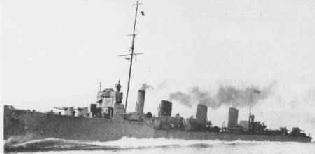Faulknor-class flotilla leader
 | |
| Class overview | |
|---|---|
| Operators: | |
| Preceded by: | Medea class |
| Succeeded by: | Marksman class |
| Completed: | 4 |
| Lost: | 1 |
| General characteristics | |
| Type: | Faulknor-class destroyer leader |
| Displacement: | 1,700 tons |
| Tons burthen: | 1,850 tons |
| Length: | 331 ft (101 m) o/a |
| Beam: | 32 ft 6 in (9.91 m) |
| Draught: | 11 ft (3.4 m) |
| Propulsion: | 6× White-Forster boilers, steam turbines, 3 shafts, 30,000 shp |
| Speed: | 32 knots (59 km/h; 37 mph) |
| Range: | 403 tons coal, 83 tons oil |
| Complement: | 197 - 205 |
| Armament: |
|
The Faulknor class were a class of flotilla leaders that were under construction in the United Kingdom for the Chilean Navy at the outbreak of World War I. These ships were purchased by the British, taken over and completed for the Royal Navy for wartime service. In common with Royal Navy convention, they were named after famous Royal Navy captains of the past, in this case the members of the Faulknor family.
Design
The six Almirante Lynch-class destroyers were a private design by J. Samuel White that were significantly larger and heavier armed than their contemporaries. They had four funnels, a tall, narrow fore funnel and three broad, short funnels behind. They were initially armed with six single QF 4-inch guns, unusually arranged with four on the forecastle - two sided in front of the wheelhouse and two sided abreast it - the remaining pair being sided on the quarterdeck. These guns were of a novel Elswick design for the Chileans and when the ships were rearmed they were replaced with standard Royal Navy models. As rearmed in 1918 they carried a BL 4.7-inch gun on the forecastle and another on a bandstand between the after pair of funnels, retained the pair of 4-inch (100 mm) guns abreast the wheelhouse and had two QF 2-pounder pom-poms.
The four ships taken over by the Royal Navy were returned to the friendly nation of Chile in 1920, at which point the Thornycroft type leader Rooke was renamed Broke to maintain this famous name (that of Admiral Sir Philip Bowes Vere Broke of the Shannon) in the Navy List.
Service
All of the class were present at the Battle of Jutland on 31 May to 1 June 1916 where Broke collided with and sank the Acasta-class destroyer Sparrowhawk. Also in this action, Tipperary, serving with the 4th Destroyer Flotilla, was hit by 5.9-inch (150 mm) fire from the secondary battery of the German dreadnought Westfalen and sank with the loss of 185 hands from her crew of 197.
In April 1917, Broke took part in an action known as the Battle of Dover Strait with equally large singleton Swift during which she was damaged.
Botha was damaged in the English Channel on 21 March 1918 off the coast of Flanders when she rammed and sank the German torpedo boat A-19 and was then torpedoed in error by the French destroyer Capitaine Mehl.
Ships
| Name | Ship Builder | Launched | Completed | Fate |
|---|---|---|---|---|
| Faulknor (ex-Almirante Simpson) | J S White, Cowes | February 26, 1914 | Completed 1914 | Returned to Chile 1920 |
| Broke (ex-Almirante Goñi) | J S White, Cowes | May 25, 1914 | 1914 | Returned to Chile 1920 |
| Botha (ex-Almirante Williams Rebolledo) | J S White, Cowes | 2 December 1914 | 1915 | Returned to Chile 1920 |
| Tipperary (ex-Almirante Riveros) | J S White, Cowes | March 5 1915 | 1915 | Sunk by gunfire at Battle of Jutland, May 31, 1916 |
See also
| Wikimedia Commons has media related to Faulknor class leader. |
Almirante Lynch-class destroyers for details after return to Chile.
Bibliography
- Destroyers of the Royal Navy, 1893-1981, Maurice Cocker, 1983, Ian Allan ISBN 0-7110-1075-7
- Jane's Fighting Ships, 1919, Jane's Publishing